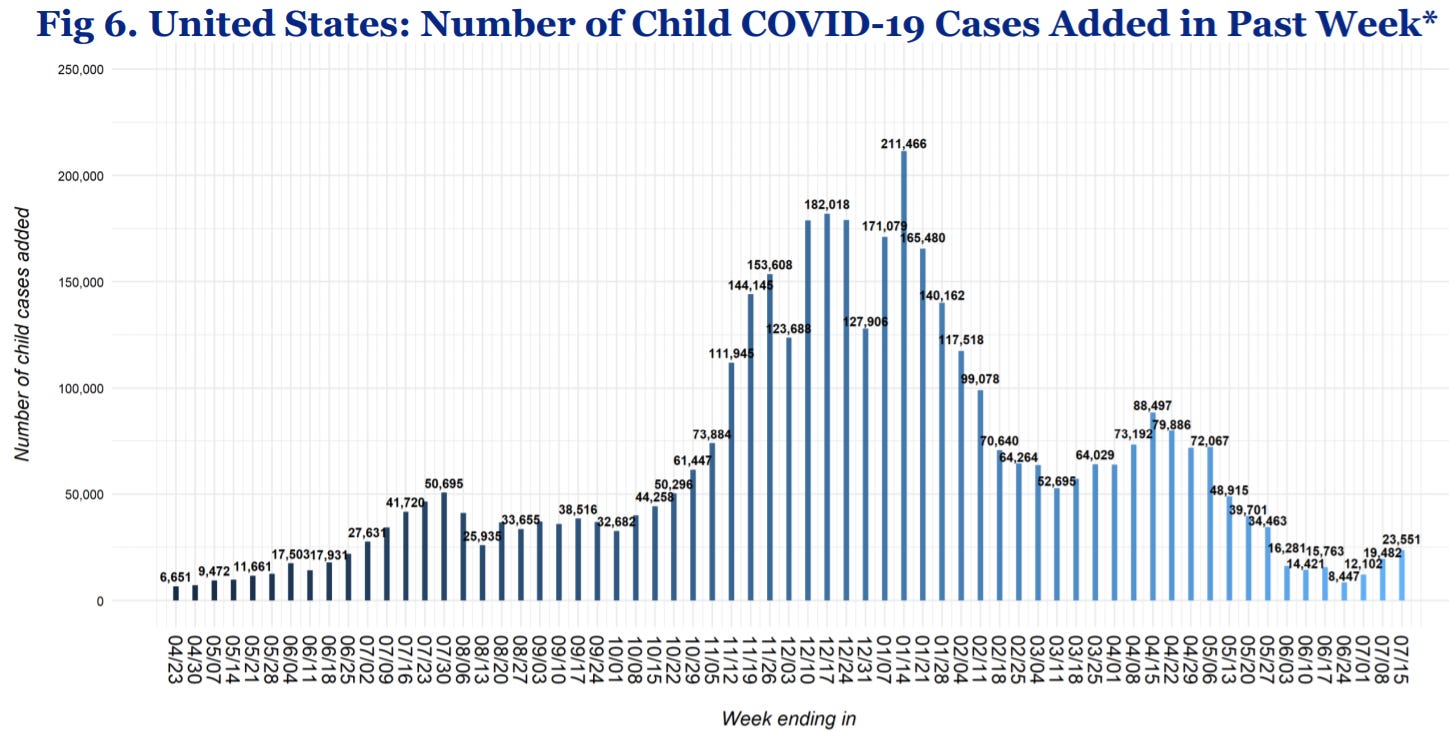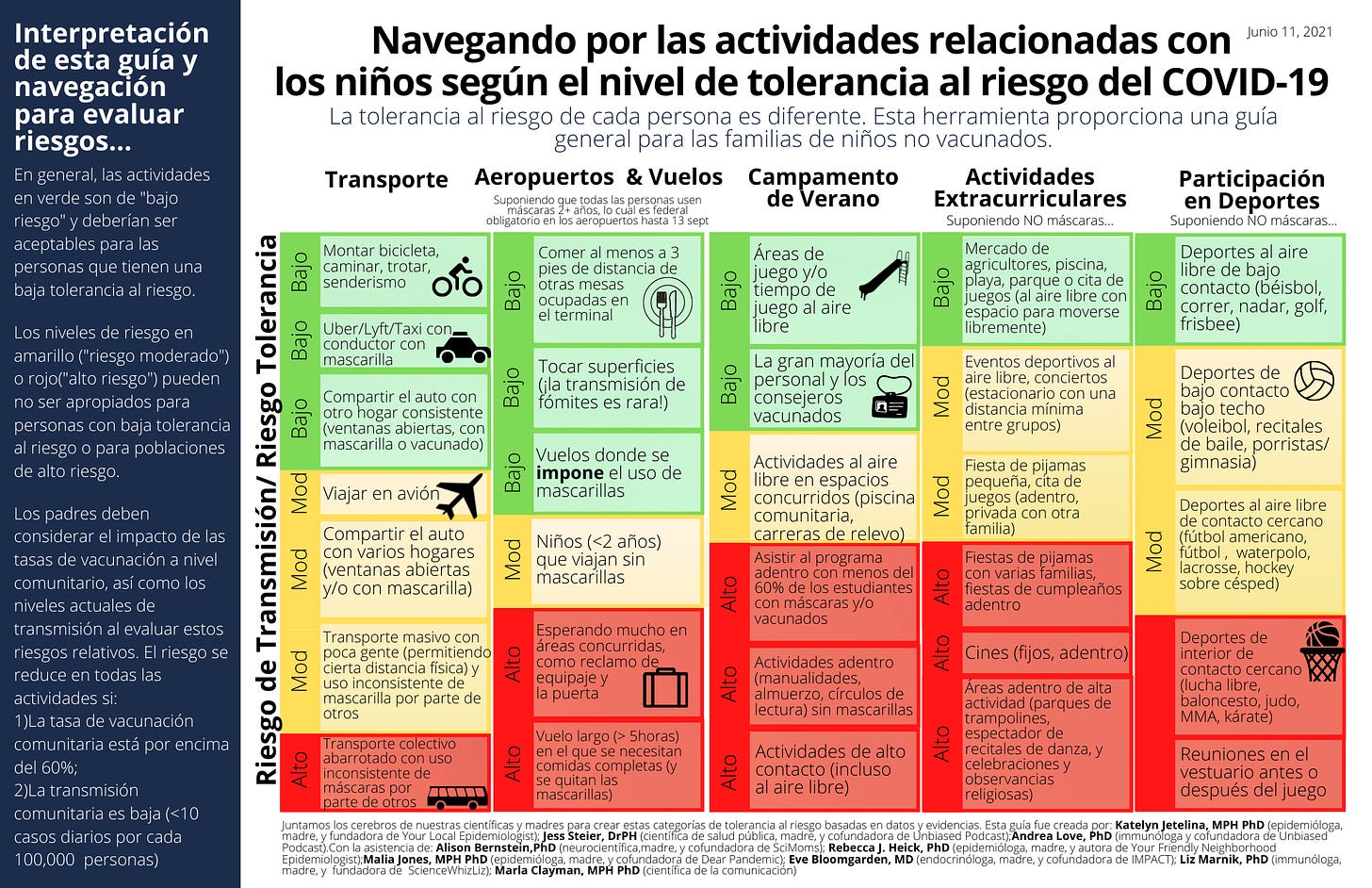My inbox is flooded with really great questions from parents. Here is my attempt to answer the most pressing and frequent ones…
“How is Delta affecting kids?”
Delta is 200% more transmissible, so more kids will get it (just like more unvaccinated adults will get it). Delta also has a 1000% higher viral load, which means kids will test positive more quickly following exposure. This also means people are shedding a ton more virus, so if your kid comes in contact with a positive COVID19 case, the probability of getting infected increases. If your kid becomes positive, they have more opportunity to infect others too.
The primary mode of transmission is still direct contact and inhaled particles. Higher transmissibility does not mean Delta is transferred in more aerosol form than before.
We do not know if Delta is more severe for kids (or adults) than previous variants. A higher viral load does not necessarily mean increased severity. A recent Lancet study found the hospitalization rate of adults was 85% higher than other variants, but other studies show severity is no different. The consensus among scientists: Jury is still out.
“How many pediatric cases are there and is the rate increasing?”
Last week, 23,551 pediatric COVID-19 cases were reported and kids represented 15.9% of all cases in the United States. This percentage will continue to increase as more and more adolescents and adults get vaccinated.
In 23 states, 2.3% of COVID19 hospitalizations are children (children hospitalized / everyone hospitalized) and the hospitalization rate among kids (hospitalized / infected) remains to be 0.9%.
In the past 14 days, there’s been a 94.6% increase in pediatric cases. Raw pediatric cases (first graph) continues to follow national trends, which means they do not seem disproportionally impacted by Delta compared to adults. But, both pediatric and adult cases continue to rise, which is concerning in and of itself.
“What is the rate of long COVID19 among kids?”
We still don’t know. There’ve been a few studies on this topic, but the rate drastically ranges from 2% to 50%. The British National Health Service (NHS) is reporting numbers between 7-8% and opening new pediatric clinics for long COVID19 around the country.
We also don’t really know what makes some kids more susceptible to long COVID19 than others. Teenagers and females seem to be at higher risk, but it’s happening across all ages and genders.
“The American Academy of Pediatrics recommends masks indoors among vaccinated kids. Why?”
The American Academy of Pediatrics (AAP) updated their recommendations this morning stating: “Everyone older than age 2 [should] wear masks, regardless of vaccination status”. The AAP provided justification:
A significant portion of the student population is not yet eligible for vaccines;
Masking is proven to reduce transmission of the virus and to protect those who are not vaccinated;
Many schools will not have a system to monitor vaccine status of students, teachers and staff; and,
Some communities overall have low vaccination uptake where the virus may be circulating more prominently.
This goes against CDC’s recommendations that vaccinated people do not need to wear masks inside. AAP made the right move. We need to curb transmission and protect the unvaccinated. Whether your kids (or you) are vaccinated or not, wear a mask inside.
“When will the FDA approve vaccines for <12 years?”
If all goes well… late Fall. My educated guess is November. Vaccine sponsors are testing smaller doses for kids, so they had to start from square one (i.e., Phase I). Phase I is complete and Phase II/III is well on it’s way. Pfizer is confident that they will have enough data by September. Then this will go to the FDA/CDC for review. Then new dosage vaccines will be distributed. And then it can go into arms. Moderna will be close behind.
“Can I (a vaccinated parent) transmit the virus to my (unvaccinated) kids?”
Yes. During pre-Delta, vaccines reduced transmission by a lot (85-90%), but they’re not perfect (100%). So, yes you can give the virus to your kids, although it’s much less probable than an unvaccinated person. We do not know how Delta changes the game. Delta is stickier with a higher viral load, so Delta has the potential to transmit from vaccinated to unvaccinated higher than before. But we just don’t know yet.
“Do my kids need to change their activities because of Delta?”
The graphic that I created a few weeks ago is still accurate in the wake of Delta. If transmission is high in your county (check here), then I strongly suggest jumping down one risk level. For example, I was a solid “yellow” parent before Delta. Because my community has substantial transmission, I am a solid “green” parent now. If you’re a “red” parent, it’s time to go to “yellow” or “green”. This will not only help protect your child, but will help your community stop transmission too.
“Can I ask teachers if they’re vaccinated?”
Yes. And you should. It’s not a HIPAA violation. (Read my previous post about this here). However, they don’t have to answer you. I’ve found some organizations are more comfortable providing aggregate numbers. So, for example, XX% of teachers are vaccinated at my kids’ childcare. This will at least give you a sense of the school climate.
It’s also time to ask others that are around your kid for extended periods of time. For example, I asked my daughter’s swim teacher if she was vaccinated. Be an advocate for your child’s health. You don’t have to be rude, but you certainly don’t have to feel bad about asking either.
Bottom Line: We’re still learning a lot about Delta and driving the ship as it’s built. There are a lot of unknowns, as we can only get evidence-based, data driven answers so fast. Please be patient with the process. Rigorous science is worth it in the end, I promise. In the meantime, stick to what we know…masks work and a layered protection level works even better for our kids and our communities. Remain vigilant.
Love, YLE









Thank you! I read that the Pfizer vaccine for kids under 12 won’t be ready until mid winter (December - February)? November sounds great but is too too good to be true?
Thank you so much for all your work! Based on the chart and with school starting soon in some states that won't allow for required making indoors - we're all struggling to navigate what to do. We're reaching out to have our voice heard with our school, but in the meantime trying to plan in case there isn't universal making. Any advice for approaching school specifically?